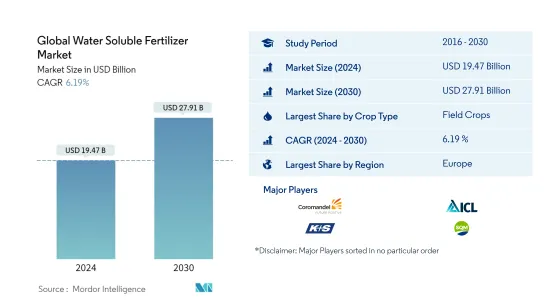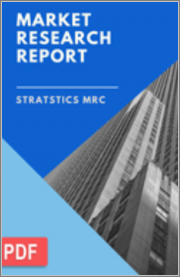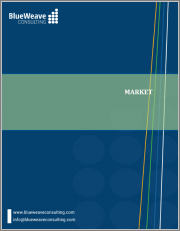
|
시장보고서
상품코드
1440536
수용성 비료 : 세계 시장 점유율 분석, 산업 동향 및 통계, 성장 예측(2024-2030년)Global Water Soluble Fertilizer - Market Share Analysis, Industry Trends & Statistics, Growth Forecasts (2024 - 2030) |
||||||
세계 수용성 비료 시장 규모는 2024년 194억 7,000만 달러로 추정되며, 예측 기간(2024-2030년) 동안 6.19%의 연평균 복합 성장률(CAGR)로 성장하여 2030년까지 279억 1,000만 달러에 달할 것으로 예상됩니다.

주요 하이라이트
- 유형별 최대 부문 - 인산 비료: 인산 비료는 질소 다음으로 가장 많이 소비되는 비료입니다. 비료의 수용성 형태에 대한 수요가 증가하고 있는데, 이는 시비 및 엽면 살포가 가능하기 때문입니다.
- 유형별 가장 빠른 성장 - 미량 영양소: 엽면 살포는 식물의 요구 사항에 따라 미량 영양소를 공급하는 입증된 효과적인 방법입니다. 비료가 식물의 혈관 시스템에 직접 적용되기 때문에 영양소 이용 효율이 향상되고 작물이 빠르게 반응합니다.
- 작물 유형별 최대 부문 - 잔디 및 관상용: 오염에 대한 우려가 높아지고 전 세계적으로 생태 관광이 확대됨에 따라 경작 면적이 증가하고 있으며, 이에 따라 이러한 작물에 대한 비료 수요가 증가하고 있습니다.
- 국가별 최대 시장인 미국: 국내 마이크로 관개 시스템의 발전과 효율성 향상에 따라 질소 비료와 같은 수용성 비료의 인기가 높아지고 있습니다.
수용성 비료 시장 동향
밭작물은 작물 유형별로 가장 큰 부문입니다.
- 전 세계적으로 밭작물 재배는 수용성 비료의 총 소비량의 약 80.0%를 차지하며, 전 세계적으로 밭작물 재배가 주류를 이루고 있습니다. 2021년 수용성 비료 소비량은 3,405만 톤, 금액으로는 247억 6,000만 달러에 달할 전망입니다. 밭작물에 의한 수용성 비료의 대량 소비는 이들 작물의 재배 면적이 넓기 때문입니다. 전 세계 농지의 90.0% 이상이 밭작물 재배에 사용되고 있습니다.
- 일반적으로 원예 작물은 스프링클러, 마이크로 관개 시스템 등 관개 시설이 잘 갖추어져 있기 때문에 수용성 비료에 대한 수요가 높습니다. 수용성 비료는 엽면 시비법 또는 시비 시비법에 의해 적용될 수 있습니다. 원예 작물은 수용성 비료를 소비하는 작물 중 두 번째로 많은 작물로 2021년 세계 수용성 비료 시장 가치의 약 12.2%를 차지했습니다. 엽면 수용성 비료는 과수 작물에서 중요한 역할을 합니다. 엽면 살포는 과일의 품질을 향상시키는 것으로 알려져 있습니다.
- 잔디 및 관상용 작물은 전 세계 수용성 비료 시장 가치의 약 7.12.29%를 차지했으며 2021 년에는 10억 달러에 해당하는 3 백만 톤의 수용성 비료가 소비되었습니다.
- 환경오염에 대한 우려와 세계적으로 아름다운 조경 정원과 생태관광의 중요성이 높아지면서 잔디 및 관상용 작물 재배 면적이 증가하고 있습니다.
- 따라서 각 작물 유형별 세계 수용성 비료 소비량은 예측 기간 동안 증가할 것으로 예상됩니다.
지역별로는 유럽이 가장 큰 부문입니다.
- 세계 수용성 비료 시장은 조사 기간 동안 안정적인 성장을 보였으며 2021년 시장 규모는 30억 9,950만 달러에 달했으며, 2021년 유럽이 35.2%로 가장 큰 시장 점유율을 차지했으며, 아시아태평양, 남미가 그 뒤를 이었습니다.
- 프랑스, 러시아 등 국가에서 특수 비료 사용이 증가함에 따라 유럽에서 수용성 비료 시장이 성장하고 있습니다. 이 지역의 수용성 비료는 2021년 특수 비료 시장 총액의 약 54.5%, 같은 해 특수 비료 총량의 약 46.7%를 차지했습니다.
- 중국과 인도와 같은 신흥국은 늘어나는 인구를 먹여 살리기 위해 2030년까지 1억 2,000만 헥타르 이상의 농업 면적이 필요할 것입니다. 농지의 사막화와 토양 품질 저하에도 불구하고 수용성 비료는 농부들이 지속 가능한 농업을 영위하는 데 필수적인 도구로 남아있습니다. 수확량을 증가시킵니다.
- 브라질에서는 비료 시비 방식이 점점 더 인기를 얻고 있으며 2021년 전체 특수 비료 시장의 47.78%를 차지했습니다. 브라질에서 마이크로 관개 시스템 증가와 비료 시비의 용이성과 효율성 향상으로 인해 수용성 비료에 대한 수요가 증가하고 있습니다.
- 남아프리카공화국 수용성 비료 시용의 58.78%는 비료 시용이며, 엽면 살포는 41.21%를 차지합니다. 이는 시비 방법의 적응률과 적용의 용이성 및 효율성에 따른 수용성 비료의 적용 범위를 보여줍니다.
- 온실에서 수용성 비료 사용, 지하수 소비를 줄이기 위한 인센티브, 정부 보조금, 마이크로 관개 시스템에 대한 수요 증가는 시장 성장을 가속하는 주요 요인 중 일부입니다.
수용성 비료 산업 개요
세계 수용성 비료 시장은 세분화되어 있으며, 상위 5개 기업이 20.89%를 점유하고 있습니다. 이 시장의 주요 기업은 Coromandel, Israel Chemical Limited, K S AKTIENGESELLSCHAFT, Sociedad Quimica YMinera SA(SQM) 및 Yara International ASA(알파벳순)입니다.
기타 혜택
- 엑셀 형식 시장 예측(ME) 시트
- 3개월간 애널리스트 지원
목차
제1장 주요 요약과 주요 조사 결과
제2장 보고서 제공
제3장 서론
- 조사의 전제조건과 시장의 정의
- 조사 범위
- 조사 방법
제4장 주요 업계 동향
- 주요 작물 작부 면적
- 평균 영양소 적용율
- 규제 프레임워크
- 밸류체인과 유통 채널 분석
제5장 시장 세분화
- 유형
- 컴플렉스
- 스트레이트
- 영양소
- 미량영양소
- 질소성
- 인산염
- 칼륨
- 2차 주요 영양소
- 사용법
- 적하
- 엽면
- 작물 유형
- 밭작물
- 원예 작물
- 잔디 및 관상용
- 지역
- 아시아태평양
- 호주
- 방글라데시
- 중국
- 인도
- 인도네시아
- 일본
- 파키스탄
- 필리핀
- 태국
- 베트남
- 기타 아시아태평양
- 유럽
- 프랑스
- 독일
- 이탈리아
- 네덜란드
- 러시아
- 스페인
- 우크라이나
- 영국
- 기타 유럽
- 중동 및 아프리카
- 나이지리아
- 사우디아라비아
- 남아프리카공화국
- 터키
- 기타 중동 및 아프리카
- 북미
- 캐나다
- 멕시코
- 미국
- 기타 북미
- 남미
- 아르헨티나
- 브라질
- 기타 남미
- 아시아태평양
제6장 경쟁 구도
- 주요 전략적 동향
- 시장 점유율 분석
- 회사 상황
- 기업 개요
- BMS Micro-Nutrients NV
- Compo Expert
- Coromandel
- Haifa Group
- IFFCO
- Israel Chemical Limited
- K+S AKTIENGESELLSCHAFT
- Sociedad Quimica YMinera SA(SQM)
- Yara International ASA
제7장 CEO에 대한 주요 전략적 질문
제8장 부록
- 세계의 개요
- 개요
- Porter's Five Foeces 프레임워크
- 세계 밸류체인 분석
- 시장 역학(DRO)
- 출전과 참고 문헌
- 표와 그림 리스트
- 주요 인사이트
- 데이터 팩
- 용어집
The Global Water Soluble Fertilizer Market size is estimated at USD 19.47 billion in 2024, and is expected to reach USD 27.91 billion by 2030, growing at a CAGR of 6.19% during the forecast period (2024-2030).

Key Highlights
- Largest segment by Type - Phosphatic : phosphatic fertilizers are the most consumed fertilizers after nitrogen. The demand for its water-soluble form is increasing as it can be applied through fertigation and foliar spray.
- Fastest growing by Type - Micronutrients : Foliar application is a proven effective method of supplying micronutrients according to plant requirements. Since the fertilizer is applied directly to the plant vascular system, the nutrient use efficiency will be increased, and quick response is observed by crop plants
- Largest Segment by Crop Type - Turf & Ornamental : The increasing area under cultivation with increasing concern over pollution and growing ecotourism across the globe has increased the fertilizer demand for such crops.
- Largest segment by Country - United States : With the developing micro-irrigation system in the country and increased efficiency, water-soluble fertilizers such as nitrogenous fertilizers have increased in popularity.
Water Soluble Fertilizer Market Trends
Field Crops is the largest segment by Crop Type.
- Field crop cultivation dominates globally, and it accounts for about 80.0% of the total water-soluble fertilizer consumption. The consumption amounted to 34.05 million metric ton of water-soluble fertilizers worth USD 24.76 billion in 2021. The large consumption of water-soluble fertilizers by field crops is due to the large area under the cultivation of these crops. More than 90.0% of the global agricultural land is dedicated to the cultivation of field crops.
- Generally, there is more demand for water soluble fertilizers in horticultural crops, as they are well-equipped for irrigation like sprinkler or micro irrigation systems. Water-soluble fertilizers can be applied by the foliar or fertigation method of application. The Horticultural crops are the second-largest crop types that consume water-soluble fertilizers, and they accounted for about 12.2% of the global water-soluble fertilizer market value in 2021. Foliar water-soluble fertilizers play an important role in fruit crops, as foliar spraying is known to improve the quality of the fruits.
- Turf and ornamental crops account for about 7.12.29 % of the global water-soluble fertilizer market value and consumed 3.0 million metric ton of water-soluble fertilizers worth USD billion in 2021.
- The area under cultivation of turf and ornamental crops is increasing with concern over pollution and the growing importance of aesthetic landscaping gardens and ecotourism globally.
- Therefore, the global consumption of water-soluble fertilizers in respective crop types is anticipated to grow during the forecast period.
Europe is the largest segment by Region.
- The global water-soluble fertilizer market grew at a stable rate during the study period, with a value of USD 30.95 billion in 2021. Europe occupied the largest market share of 35.2% in 2021, followed by Asia Pacific and South America.
- Due to an increase in the use of specialized fertilizers in nations like France and Russia, the market for water-soluble fertilizers in Europe has been growing. The water-soluble fertilizers in the region accounted for about 54.5% of the total specialty fertilizer market value in 2021 and for about 46.7% of the total volume of specialty fertilizers in the same year.
- To feed their rising populations, developing countries like China and India will need more than 120 million hectares of agriculture by 2030. Despite the desertification of farmland and the decline in soil quality, water-soluble fertilizers remain an essential tool for farmers to help them sustainably increase yields.
- The fertigation mode of application has grown in popularity in Brazil and accounted for 47.78% of the total specialty fertilizer market in 2021. With the country's increasing micro irrigation system and ease of application and increased efficiency, the demand for water-soluble fertilizers.
- Fertigation accounts for 58.78% of water-soluble fertilizer applications in South Africa, and foliar spraying accounts for 41.21%. This indicates the rate of fertigation method adaptation and the scope of water-soluble because of the ease of application and efficiency.
- The use of water-soluble fertilizers in greenhouses, incentives to reduce groundwater consumption, government subsidies, and an increase in demand for micro irrigation systems are some of the main factors boosting the growth of the market.
Water Soluble Fertilizer Industry Overview
The Global Water Soluble Fertilizer Market is fragmented, with the top five companies occupying 20.89%. The major players in this market are Coromandel, Israel Chemical Limited, K+S AKTIENGESELLSCHAFT, Sociedad Quimica YMinera SA (SQM) and Yara International ASA (sorted alphabetically).
Additional Benefits:
- The market estimate (ME) sheet in Excel format
- 3 months of analyst support
TABLE OF CONTENTS
1 EXECUTIVE SUMMARY & KEY FINDINGS
2 REPORT OFFERS
3 INTRODUCTION
- 3.1 Study Assumptions & Market Definition
- 3.2 Scope of the Study
- 3.3 Research Methodology
4 KEY INDUSTRY TRENDS
- 4.1 Acreage Of Major Crop Types
- 4.2 Average Nutrient Application Rates
- 4.3 Regulatory Framework
- 4.4 Value Chain & Distribution Channel Analysis
5 MARKET SEGMENTATION
- 5.1 Type
- 5.1.1 Complex
- 5.1.2 Straight
- 5.1.2.1 By Nutrient
- 5.1.2.1.1 Micronutrients
- 5.1.2.1.2 Nitrogenous
- 5.1.2.1.3 Phosphatic
- 5.1.2.1.4 Potassic
- 5.1.2.1.5 Secondary Macronutrients
- 5.2 Application Mode
- 5.2.1 Fertigation
- 5.2.2 Foliar
- 5.3 Crop Type
- 5.3.1 Field Crops
- 5.3.2 Horticultural Crops
- 5.3.3 Turf & Ornamental
- 5.4 Region
- 5.4.1 Asia-Pacific
- 5.4.1.1 Australia
- 5.4.1.2 Bangladesh
- 5.4.1.3 China
- 5.4.1.4 India
- 5.4.1.5 Indonesia
- 5.4.1.6 Japan
- 5.4.1.7 Pakistan
- 5.4.1.8 Philippines
- 5.4.1.9 Thailand
- 5.4.1.10 Vietnam
- 5.4.1.11 Rest Of Asia-Pacific
- 5.4.2 Europe
- 5.4.2.1 France
- 5.4.2.2 Germany
- 5.4.2.3 Italy
- 5.4.2.4 Netherlands
- 5.4.2.5 Russia
- 5.4.2.6 Spain
- 5.4.2.7 Ukraine
- 5.4.2.8 United Kingdom
- 5.4.2.9 Rest Of Europe
- 5.4.3 Middle East & Africa
- 5.4.3.1 Nigeria
- 5.4.3.2 Saudi Arabia
- 5.4.3.3 South Africa
- 5.4.3.4 Turkey
- 5.4.3.5 Rest Of Middle East & Africa
- 5.4.4 North America
- 5.4.4.1 Canada
- 5.4.4.2 Mexico
- 5.4.4.3 United States
- 5.4.4.4 Rest Of North America
- 5.4.5 South America
- 5.4.5.1 Argentina
- 5.4.5.2 Brazil
- 5.4.5.3 Rest Of South America
- 5.4.1 Asia-Pacific
6 COMPETITIVE LANDSCAPE
- 6.1 Key Strategic Moves
- 6.2 Market Share Analysis
- 6.3 Company Landscape
- 6.4 Company Profiles
- 6.4.1 BMS Micro-Nutrients NV
- 6.4.2 Compo Expert
- 6.4.3 Coromandel
- 6.4.4 Haifa Group
- 6.4.5 IFFCO
- 6.4.6 Israel Chemical Limited
- 6.4.7 K+S AKTIENGESELLSCHAFT
- 6.4.8 Sociedad Quimica YMinera SA (SQM)
- 6.4.9 Yara International ASA
7 KEY STRATEGIC QUESTIONS FOR FERTILIZER CEOS
8 APPENDIX
- 8.1 Global Overview
- 8.1.1 Overview
- 8.1.2 Porter's Five Forces Framework
- 8.1.3 Global Value Chain Analysis
- 8.1.4 Market Dynamics (DROs)
- 8.2 Sources & References
- 8.3 List of Tables & Figures
- 8.4 Primary Insights
- 8.5 Data Pack
- 8.6 Glossary of Terms



















